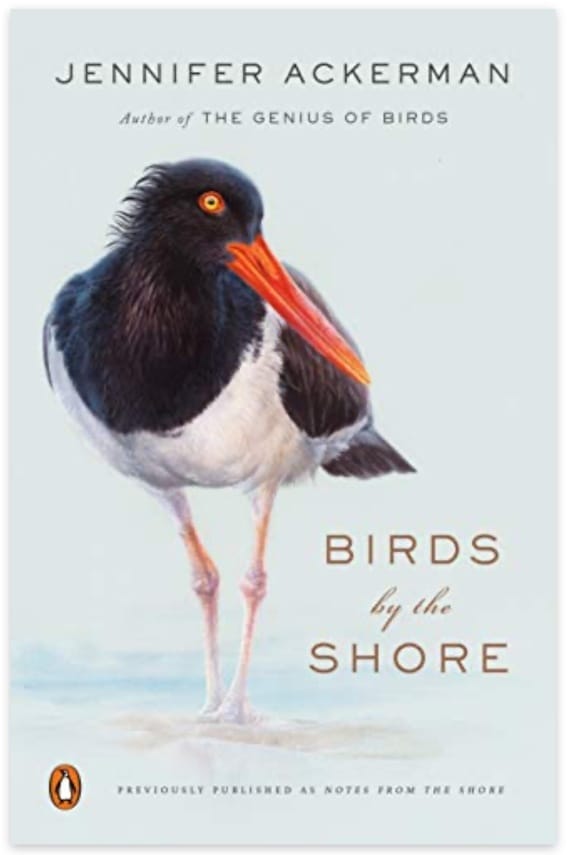By Michele T Logarta
While field guides are essential to birding, there are many other tomes of interest to the bird watching bookworm. This section features those other books, fiction and nonfiction, about birds, birders, nature, and the environment. For this issue of eBon, I chose again a book by award-winning science writer Jennifer Ackerman.

Birds by the Shore
By Jennifer Ackerman
Paperback edition
New Edition Published by Penguin Books (2019)
(First published in 1995 by Penguin Books)
Non Fiction
How many landscapes fit inside the human heart?
Jennifer Ackerman pondered on this question in her book Birds by the Shore. What places did one go or live in that left indelible imprints on one’s mind and heart?
For Ackerman, the coastal town of Lewes in Delaware, USA, is one such place and it is the setting of this book, a collection of essays on her three years there. She took many walks along its shores, exploring the natural life, observing the shorebirds and seabirds, listening to the sounds of the ocean, watching the tides ebb and flow.
Of Lewes, she said: One is always aware of the sea in Lewes, can feel its broad, enduring presence just over the fat humps of sand dunes, It affects people as surely as it breeds rhythms into the fiddler crab.
In the essay entitled Osprey, she told of her encounters with this bird species. “The osprey,”she declared, “leapt into my heart.”
At the time, Ackerman recounted, the birds were literally her neighbors, with five active nests within a 3-5 mile radius of her home.
“The osprey’s huge nests, most of them in open, public spaces, and its showy method of hunting—a plummeting dive ending in a flare of spray—made it a conspicuous neighbor, familiar and expected,” she wrote.
In Delaware, the ospreys are considered to be the harbingers of Spring. When they arrive, you know Spring has come. And as Ackerman noted, they start arriving a day or two after St Patrick’s Day (March 17th) and their appearance always makes news in the local papers.
In another essay in the book, she paid tribute to a place called the Great Marsh. She described it as a “broad plain of mud and grass” and a “landscape of no relief, flat and featureless” yet it is one she often walked in, at times in the darkness, just before the sun rose. The darkness of the marsh, she opined, “is not the close darkness of woods, where blackness pours up from between the trees, but a thin, liquid, open, far-reaching darkness that descends onto the grass.”
For many months after moving to Lewes, Ackerman could not comprehend what attractions the marsh held. A summer spent in the marsh with a scientist from the Delaware Division of Fish and Wildlife finally revealed secrets of the marsh to her. The scientist, whose job was to record the species and number of animals that use the ponds in the marsh, sat with her, and while watching for waterfowl, pointed out to her the different kinds of marsh plants. Suddenly, she said, the marsh vegetation had become recognizable from the bewildered entanglement it once was.
In this piece, Ackerman spoke also of the how marshes, swamps and wetlands in general are regarded as wastelands, where nothing lives. “The orderly ousting of the low, wet lands along this coast is not a new thing. For hundreds of years, people have considered these realms miasmic. The only good marsh was a drained marsh,” she noted, was a long held, misguided belief.
The author cited a proposed solution to the destruction of wetlands but questioned it. “The idea is this: Anyone who destroys a wetland must create one of a similar size somewhere else. Plant some grass, introduce some keystone species, and hope that these serve as a sort of gravitational force that will draw in the myriad elements of a marsh community.”
Ackerman doubted this will ever work. For no new marsh, she said, “can recreate the complex chemistry of mud cooked over a millennia.”
Ackerman’s time at Lewes was a quiet and reflective time spent close to nature.
In the beginning, she recalled seeing only surfaces and facades where the mudflats were just seemingly barren wastelands and marshes just a sea of sameness.
In the end, she said: “I’ve learned that the way into a new landscape is to pull at a single thread, Ackerman said, “Nearly always, it will lead to the heart of the tangle.”
Wetlands are a haven for birds and other wildlife. They sustain humans too. Science shows that wetlands are important for flood protection, water quality improvement, shoreline erosion control, among other things.
Here in the Philippines where wetlands are embattled, constantly under siege and threat of developers and reclamation, we and—very importantly our policymakers and lawmakers— would do well to pull at that single thread Ackerman speaks of. For to pull it would unravel the life and beauty that abounds in it as well as its immeasurable value to all forms of life.
Ackerman had three years to get to know the Delaware coast and the Great Marsh and its wild creatures.These are some of the landscapes that are in her heart.
What landscapes are in ours?
###
